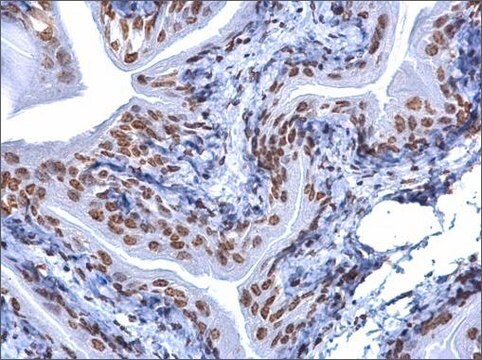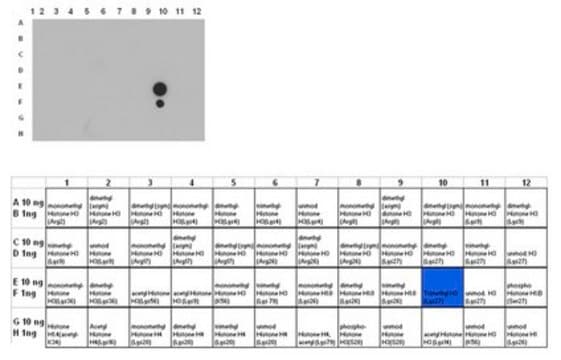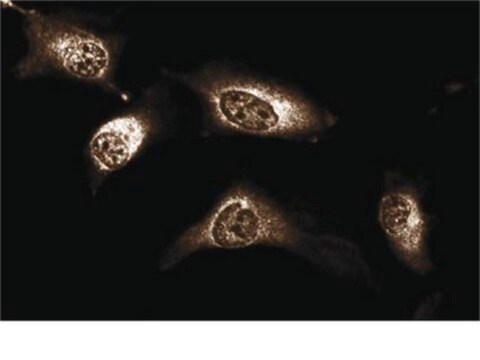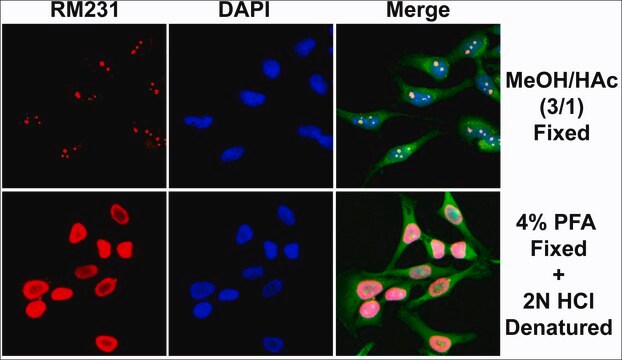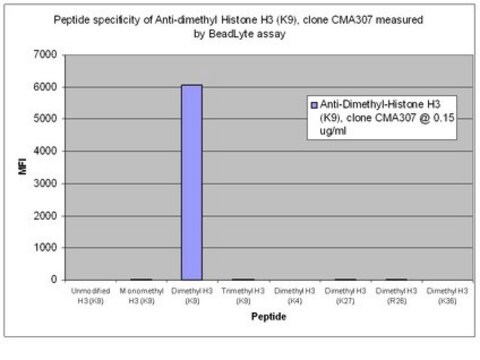05-1338
Anti-Dimethyl Histone H3 (Lys4) Antibody, clone CMA303
clone CMA303, from mouse
Synonyme(s) :
H3K4me2, Histone H3 (di methyl K4), H3 histone family, member T, histone 3, H3, histone cluster 3, H3
About This Item
Produits recommandés
Source biologique
mouse
Niveau de qualité
Forme d'anticorps
purified immunoglobulin
Type de produit anticorps
primary antibodies
Clone
CMA303, monoclonal
Espèces réactives
human, vertebrates
Technique(s)
ChIP: suitable
ELISA: suitable
dot blot: suitable
immunocytochemistry: suitable
immunoprecipitation (IP): suitable
multiplexing: suitable
western blot: suitable
Isotype
IgG1κ
Numéro d'accès NCBI
Numéro d'accès UniProt
Conditions d'expédition
wet ice
Modification post-traductionnelle de la cible
dimethylation (Lys4)
Informations sur le gène
human ... H3C1(8350)
Description générale
Spécificité
Immunogène
Application
Sonicated chromatin prepared from HeLa cells (1 X 106 cell equivalents per IP) were subjected to chromatin immunoprecipitation using 2 µg of either a normal mouse IgG, or Anti-dimethyl-Histone H3 (Lys4) antibody and the Magna ChIP G (Cat. # 17-611) Kit. Successful immunoprecipitation of dimethyl-histone H3 (Lys4) associated DNA fragments was verified by qPCR using ChIP Primers GAPDH Coding.
Please refer to the EZ-Magna G ChIP (Cat. # 17-409) or EZ-ChIP (Cat. # 17-371) protocol for experimental details.
Dot Blot Analysis:
Absurance Histone H3 Antibody Specificity Array (Cat. No. 16-667) and Absurance Histone H2A, H2B, H4 Antibody Specificity Array (Cat. No. 16-665), which contain histone peptides with various modifications were probed with Cat. No 05-1338, Anti-dimethyl H3 (Lys4), clone CMA303 at 2.0 µg/mL (1:500 dilution). Proteins were visualized using a Donkey anti-mouse IgG conjugated to HRP and a chemiluminescence detection system.
ChIP-seq Analysis:
Chromatin immunoprecipitation was performed using the Magna ChIP HiSens kit (cat# 17-10460), 2 µg of Anti-dimethyl-Histone H3 (Lys4) antibody (cat# 05-1338), 20 µL Protein A/G beads, and 1e6 crosslinked HeLa cell chromatin followed by DNA purification using magnetic beads. Libraries were prepared from Input and ChIP DNA samples using standard protocols with Illumina barcoded adapters, and analyzed on Illumina HiSeq instrument. An excess of sixteen million reads from FastQ files were mapped using Bowtie (http://bowtie-bio.sourceforge.net/manual.shtml) following TagDust (http://genome.gsc.riken.jp/osc/english/dataresource/) tag removal. Peaks were identified using MACS (http://luelab.dfci.harvard.edu/MACS/), with peaks and reads visualized as a custom track in UCSC Genome Browser (http://genome.ucsc.edu) from BigWig and BED files. The highest 25% of peaks identified in the 04-790 and 05-1338 datasets showed 92 and 90% overlap with peaks identified in the ENCODE H3K4me2 BROAD Histone track for HeLa S3.
Immunocytochemistry:
This antibody has been shown by an outside laboratory to be suitable for immunocytochemistry.
Immunoprecipitation:
This antibody has been shown by an outside laboratory to be suitable for immunoprecipitation.
ELISA:
This antibody has been shown by an outside laboratory to be suitable for ELISA
Multiplexing:
This antibody specifically recognizes histone H3 dimethylated on Lys4 by Luminex assay.
Epigenetics & Nuclear Function
Histones
Qualité
Western Blot Analysis: 2 μg/mL (1:500) dilution of this antibody detected dimethyl Histone H3 (Lys4) on 10 μg of HeLa acid extract.
Description de la cible
Forme physique
Stockage et stabilité
Remarque sur l'analyse
HeLa Acid extract lysate
Autres remarques
Clause de non-responsabilité
Not finding the right product?
Try our Outil de sélection de produits.
Code de la classe de stockage
12 - Non Combustible Liquids
Classe de danger pour l'eau (WGK)
WGK 2
Point d'éclair (°F)
Not applicable
Point d'éclair (°C)
Not applicable
Certificats d'analyse (COA)
Recherchez un Certificats d'analyse (COA) en saisissant le numéro de lot du produit. Les numéros de lot figurent sur l'étiquette du produit après les mots "Lot" ou "Batch".
Déjà en possession de ce produit ?
Retrouvez la documentation relative aux produits que vous avez récemment achetés dans la Bibliothèque de documents.
Notre équipe de scientifiques dispose d'une expérience dans tous les secteurs de la recherche, notamment en sciences de la vie, science des matériaux, synthèse chimique, chromatographie, analyse et dans de nombreux autres domaines..
Contacter notre Service technique